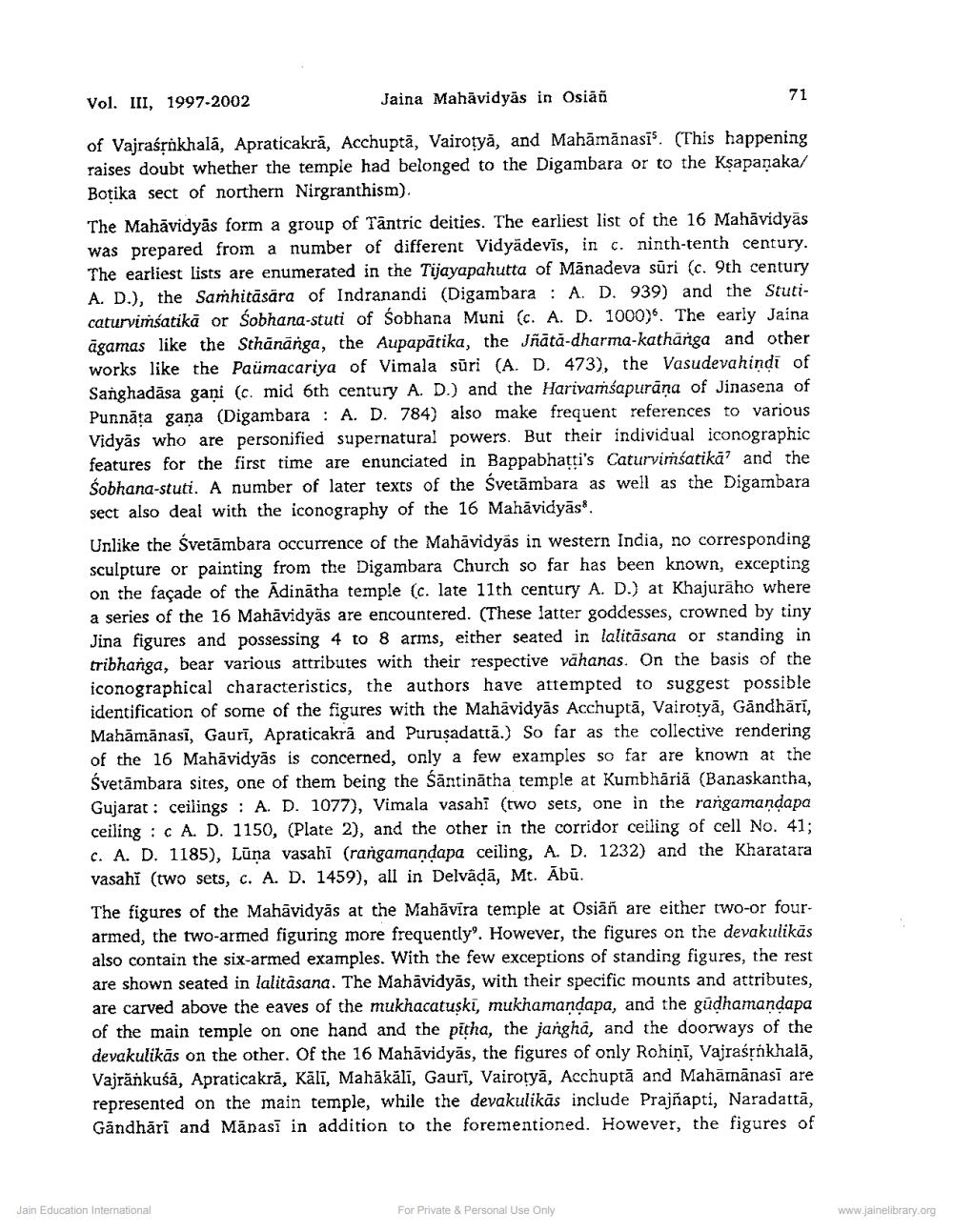________________
Vol. III, 1997-2002
Jaina Mahāvidyās in Osiäñ
71
of Vajraśộnkhala, Apraticakrā, Acchuptā, Vairotyā, and Mahāmānasi. (This happening raises doubt whether the temple had belonged to the Digambara or to the Ksapanaka/ Botika sect of northern Nirgranthism). The Mahāvidyās form a group of Tantric deities. The earliest list of the 16 Mahāvidyās was prepared from a number of different Vidyadevis, in c. ninth-tenth century. The earliest lists are enumerated in the Tijayapahutta of Mānadeva sūri (c. 9th century A. D.), the Samhitāsāra of Indranandi (Digambara: A. D. 939) and the Stuticaturvimšatikā or Sobhana-stuti of Sobhana Muni (c. A. D. 1000). The early Jaina agamas like the Sthānānga, the Aupapātika, the Jñātă-dharma-kathanga and other works like the Paümacariya of Vimala sūri (A. D. 473), the Vasudevahindi of Sanghadāsa gani (c. mid 6th century A. D.) and the Harivaṁsapurāņa of Jinasena of Punnāta gana (Digambara: A. D. 784) also make frequent references to various Vidyās who are personified supernatural powers. But their individual iconographic features for the first time are enunciated in Bappabhatti's Caturvimśatikā? and the Sobhana-stuti. A number of later texts of the Svetāmbara as well as the Digambara sect also deal with the iconography of the 16 Mahavidyās. Unlike the Svetāmbara occurrence of the Mahāvidyās in western India, no corresponding sculpture or painting from the Digambara Church so far has been known, excepting on the facade of the Adinātha temple (c. late 11th century A. D.) at Khajurāho where a series of the 16 Mahavidyās are encountered. (These latter goddesses, crowned by tiny Jina figures and possessing 4 to 8 arms, either seated in lalitāsana or standing in tribhanga, bear various attributes with their respective vähanas. On the basis of the iconographical characteristics, the authors have attempted to suggest possible identification of some of the figures with the Mahavidyās Acchuptā, Vairotyā, Gāndhārī, Mahāmānasi, Gaurī, Apraticakra and Puruşadattā.) So far as the collective rendering of the 16 Mahāvidyās is concerned, only a few examples so far are known at the Śvetāmbara sites, one of them being the śāntinātha temple at Kumbhāriä (Banaskantha, Gujarat : ceilings : A. D. 1077), Vimala vasahi (two sets, one in the rangamandapa ceiling : c A. D. 1150, (Plate 2), and the other in the corridor ceiling of cell No. 41; C. A. D. 1185), Lūna vasahi (rangamandapa ceiling, A. D. 1232) and the Kharatara vasahi (two sets, c. A. D. 1459), all in Delvādā, Mt. Ābū. The figures of the Mahāvidyās at the Mahāvira temple at Osiäñ are either two-or fourarmed, the two-armed figuring more frequently'. However, the figures on the devakulikās also contain the six-armed examples. With the few exceptions of standing figures, the rest are shown seated in lalitasana. The Mahāvidyās, with their specific mounts and attributes, are carved above the eaves of the mukhacatuski, mukhamandapa, and the gudhamandapa of the main temple on one hand and the pitha, the janghá, and the doorways of the devakulikās on the other. Of the 16 Mahāvidyās, the figures of only Rohinī, Vajraísókhalā, Vajrănkuśā, Apraticakrā, Kälī, Mahäkälī, Gaurī, Vairotyā, Acchuptā and Mahāmānasi are represented on the main temple, while the devakulikās include Prajnapti, Naradattā, Gāndhări and Manasi in addition to the forementioned. However, the figures of
Jain Education International
For Private & Personal Use Only
www.jainelibrary.org




